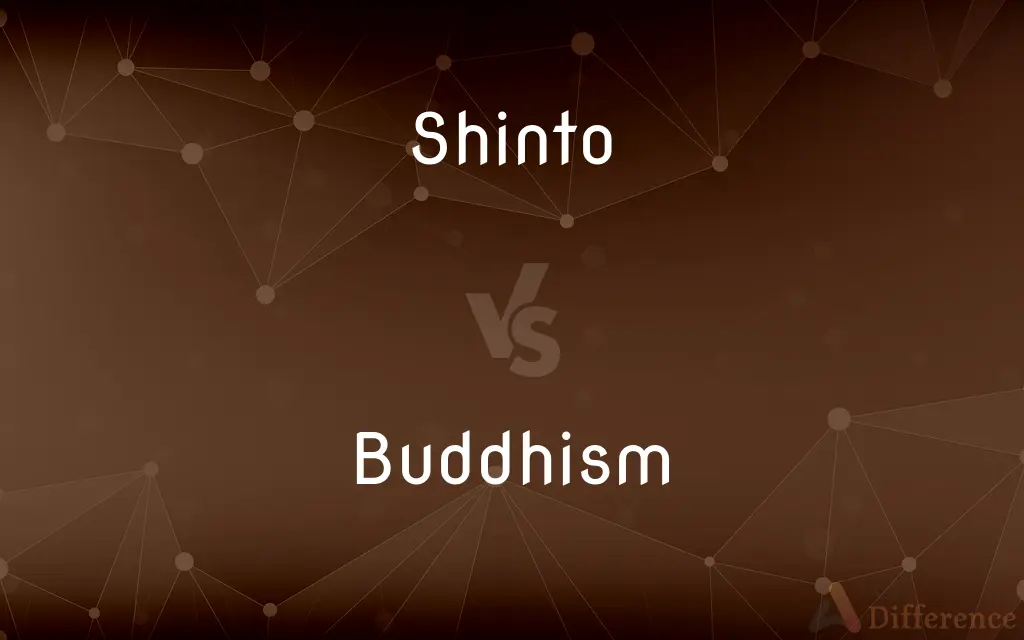Shinto vs. Buddhism — What's the Difference?
By Tayyaba Rehman & Fiza Rafique — Updated on April 16, 2024
Shinto is an indigenous Japanese religion focusing on ritual practices and kami worship, with no founder or scriptures; Buddhism, founded by Siddhartha Gautama in India, is philosophical, emphasizing meditation and enlightenment through scriptures.

Difference Between Shinto and Buddhism
Table of Contents
ADVERTISEMENT
Key Differences
Shinto, often considered the indigenous faith of Japan, emphasizes the worship of kami (spirits associated with natural features and ancestral beings). It is deeply ingrained in Japanese culture, focusing on rituals and practices that aim to maintain a connection between the present world and the spiritual realm. In contrast, Buddhism, originating in India with the teachings of Siddhartha Gautama, revolves around understanding the nature of suffering, the path to its cessation, and achieving enlightenment, primarily through meditation and ethical living.
Unlike Buddhism, which has a well-defined path towards enlightenment delineated in various scriptures like the Tripitaka, Shinto does not have a centralized set of religious texts or a founder. Shinto practices are more about maintaining tradition and the veneration of kami, which are not considered gods in a Western sense but rather spirits that inhabit the natural world. On the other hand, Buddhism provides a philosophical and ethical framework, outlined in its teachings, that guides adherents towards a deeper understanding of life and existence.
Ritual purity is central to Shinto, with numerous rituals focused on purification. These practices are integral to various aspects of Japanese life, influencing everything from domestic routines to grand festivals. Buddhism also values purity but conceptualizes it more in terms of mental and ethical purification, achieved through practices like meditation and adherence to the Noble Eightfold Path.
Shinto shrines, characterized by their distinctive architecture including torii gates, are central to the practice of Shinto, serving as homes for kami and places for communal and individual worship. Conversely, Buddhist temples are places for meditation, offering teachings, and communal gatherings, reflecting the religion's focus on community support in the pursuit of spiritual goals.
The concept of afterlife in Shinto is relatively vague, with beliefs in a form of ancestral worship and a spiritual realm closely tied to the physical world. Buddhism, however, has detailed doctrines about the afterlife, including the cycles of rebirth (samsara) and the potential for achieving Nirvana, an end to the cycle of death and rebirth.
ADVERTISEMENT
Comparison Chart
Origin
Indigenous to Japan
Originated in India
Focus
Worship of kami, rituals, purity
Enlightenment, meditation, ethics
Scriptures
None; relies on rituals and mythology
Has scriptures (e.g., Tripitaka)
Founder
No central founder
Siddhartha Gautama (Buddha)
Afterlife Beliefs
Vague, related to kami and ancestors
Detailed, includes rebirth and Nirvana
Compare with Definitions
Shinto
Rituals predominantly involving purification and offerings.
He performed a Shinto purification ritual before building his new house.
Buddhism
A philosophy and religion based on the teachings of Buddha, aimed at enlightenment.
She practices Buddhism to seek enlightenment and inner peace.
Shinto
A Japanese religion focused on kami, rituals, and festivals.
The local community attended the Shinto festival to celebrate the rice harvest.
Buddhism
The goal of achieving Nirvana, or liberation from the cycle of rebirth.
Her study of Buddhism focuses on the paths to achieving Nirvana.
Shinto
Practices and beliefs centered around natural and ancestral spirits.
They visited a Shinto shrine to pray for good fortune.
Buddhism
Belief in rebirth and the cyclical nature of life (samsara).
Buddhism teaches that life is a cycle of birth, death, and rebirth.
Shinto
A focus on living harmoniously with nature and ancestors.
Through Shinto practices, they expressed gratitude towards nature and ancestors.
Buddhism
Emphasis on meditation, ethical living, and understanding the nature of suffering.
Daily meditation is crucial in his Buddhist practice.
Shinto
No central scripture; tradition transmitted through mythology and rituals.
Shinto myths are told through dances and theatrical performances at shrines.
Buddhism
Adheres to scriptures like the Tripitaka, outlining paths to spiritual liberation.
He studied passages from the Tripitaka to deepen his understanding of Buddhism.
Shinto
Shinto (Japanese: 神道, romanized: Shintō) is a religion which originated in Japan. Classified as an East Asian religion by scholars of religion, its practitioners often regard it as Japan's indigenous religion and as a nature religion.
Buddhism
Buddhism (, US: ) is an Indian religion based on a series of original teachings attributed to Gautama Buddha. It originated in ancient India as a Sramana tradition sometime between the 6th and 4th centuries BCE, spreading through much of Asia.
Shinto
A religion native to Japan, characterized by veneration of nature spirits and ancestors and by a lack of formal dogma.
Buddhism
A widespread Asian religion or philosophy, founded by Siddartha Gautama in north-eastern India in the 5th century BC.
Shinto
One of the two great systems of religious belief in Japan. Its essence is ancestor worship, and sacrifice to dead heroes.
Buddhism
The teaching of Siddhartha Gautama that life is permeated with suffering caused by desire, that suffering ceases when desire ceases, and that enlightenment obtained through right conduct, wisdom, and meditation releases one from desire, suffering, and rebirth.
Shinto
The native religion and former ethnic cult of Japan
Buddhism
The religion represented by the many groups, especially numerous in Asia, that profess varying forms of this doctrine and that venerate Siddhartha Gautama.
Shinto
The ancient indigenous religion of Japan lacking formal dogma; characterized by a veneration of nature spirits and of ancestors
Buddhism
The religion based upon the doctrine originally taught by the Hindu sage Gautama Siddartha, surnamed Buddha, "the awakened or enlightened," in the sixth century b. c., and adopted as a religion by the greater part of the inhabitants of Central and Eastern Asia and the Indian Islands. Buddha's teaching is believed to have been atheistic; yet it was characterized by elevated humanity and morality. It presents release from existence (a beatific enfranchisement, Nirvâna) as the greatest good. Buddhists believe in transmigration of souls through all phases and forms of life. Their number was estimated in 1881 at 470,000,000.
Shinto
Relating to or characteristic of Shintoism;
Shinto temples
Buddhism
A religion represented by the many groups (especially in Asia) that profess various forms of the Buddhist doctrine and that venerate Buddha
Buddhism
The teaching of Buddha that life is permeated with suffering caused by desire, that suffering ceases when desire ceases, and that enlightenment obtained through right conduct and wisdom and meditation releases one from desire and suffering and rebirth
Common Curiosities
What is the main focus of Shinto?
The main focus of Shinto is the veneration of kami through rituals and festivals.
How does Buddhism define the path to enlightenment?
Buddhism defines the path to enlightenment through meditation, ethical living, and understanding the Four Noble Truths.
What are the ethical precepts of Buddhism?
Buddhism's ethical precepts include not killing, not stealing, right speech, right action, and right livelihood.
How does the Buddhist concept of Nirvana differ from Shinto beliefs?
Nirvana is a specific state of liberation from suffering and rebirth, distinct from Shinto’s more worldly and less defined afterlife beliefs.
What is the significance of meditation in Buddhism?
Meditation is central in Buddhism for developing mindfulness, concentration, and insight into the nature of existence.
What is a torii, and what does it symbolize in Shinto?
A torii is a traditional Japanese gate at the entrance of Shinto shrines, symbolizing the transition from the mundane to the sacred.
How do Shintoists view the afterlife?
Shinto views on the afterlife are less defined, focusing more on life and rituals related to kami and ancestors.
Are there any dietary restrictions associated with Shinto or Buddhism?
Shinto does not have specific dietary restrictions, whereas Buddhism may encourage vegetarianism, especially in its stricter schools.
Are there any central scriptures in Shinto?
Shinto does not have central scriptures; it bases its practices on rituals and oral traditions.
Can one practice both Shinto and Buddhism?
Yes, in Japan, it is common for individuals to practice both, attending Shinto rituals for some occasions and Buddhist practices for others.
What role do Buddhist temples play in the community?
Buddhist temples serve as centers for teaching, meditation, and community gatherings, supporting members in their spiritual practices.
What are the key festivals in Shinto?
Key Shinto festivals include Matsuri, which are vibrant events celebrating kami with offerings, dances, and parades.
How do Shinto rituals contribute to Japanese culture?
Shinto rituals contribute significantly to Japanese cultural festivals, rites of passage, and the annual agricultural calendar.
How does Shinto influence Japanese nationalism?
Shinto has historical ties to Japanese nationalism, particularly in how it emphasizes purity and reverence for the emperor.
How does Buddhism address modern life issues?
Buddhism addresses modern issues through its teachings on mindfulness and ethical living, applicable to contemporary moral dilemmas.
Share Your Discovery

Previous Comparison
Spinely vs. Spindly
Next Comparison
Camp vs. CompoundAuthor Spotlight
Written by
Tayyaba RehmanTayyaba Rehman is a distinguished writer, currently serving as a primary contributor to askdifference.com. As a researcher in semantics and etymology, Tayyaba's passion for the complexity of languages and their distinctions has found a perfect home on the platform. Tayyaba delves into the intricacies of language, distinguishing between commonly confused words and phrases, thereby providing clarity for readers worldwide.
Co-written by
Fiza RafiqueFiza Rafique is a skilled content writer at AskDifference.com, where she meticulously refines and enhances written pieces. Drawing from her vast editorial expertise, Fiza ensures clarity, accuracy, and precision in every article. Passionate about language, she continually seeks to elevate the quality of content for readers worldwide.















































